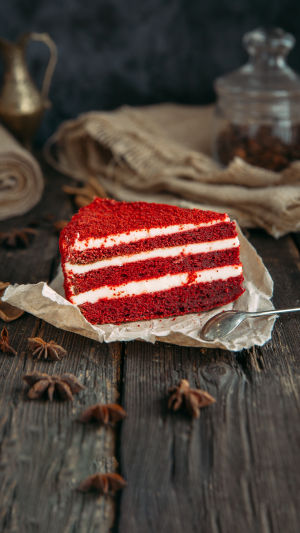Red velvet cake is not only a typical American dish but also a world-famous dessert. This cake is attractive in appearance. And if you grab a bite of it, the softness and sweetness will absolutely touch your heart.
With its lively red color contrasted with a creamy white frosting, it creates a special feeling of red velvet. But how did red velvet come into being, and how did it become so popular all over the world?
The origins of red velvet cake are a little mysterious. Some stories claim that it started in the Victorian era, in the late 1800s, when cake creators decorated cakes with beet juice or red food coloring. At the time, red was a trendy color. According to some stories, the 1920s "mahogany cake" served at the Waldorf-Astoria Hotel in New York City may have been the first red velvet cake.
Whatever its precise origins, red velvet cake seems to have gained popularity in the US during the 1930s Great Depression. Perhaps because it was made with cheap, easy-to-find components like vinegar, buttermilk, and cocoa powder, the cake was popular during hard times. The red color helped distinguish it from chocolate cakes. Some believe the vinegar's reaction with the cocoa helped enhance the red hue.
The cake gained more fame after the founder of the Waldorf-Astoria wrote a cookbook in 1981 crediting the hotel with inventing red velvet cake. This story helped fuel its popularity, even if it may not have been totally accurate. More cookbooks and media coverage followed.
Magnolia Bakery in New York’s Greenwich Village helped launch the cupcake craze in the early 2000s. Its rich red velvet cupcakes became iconic. The cake debuted in some of HBO’s famous movies and dramas, highlighting it as a fashionable dessert. Red velvet cakes and cupcakes soon exploded in popularity across the United States.
The craze for red velvet spread beyond America’s borders as well. Global restaurant chains like Starbucks, the Cheesecake Factory, and Wendy’s introduced red velvet-flavored items on international menus. Tourists and international students studying in the U.S. tasted red velvet and brought them home with enthusiasm. Social media sharing and travel shows spotlighted distinctive American foods like red velvet cake for international audiences.
The Internet and digital media accelerated this process even more. Food bloggers shared recipes and information about red velvet’s origins. Buzzfeed and other sites posted viral content lists and videos about decadent red velvet desserts. Pictures of the photogenic crimson cakes flooded platforms like Instagram and Pinterest. Through digital channels, red velvet cake attained global fame.
Today, red velvet cake and cupcakes are popular desserts in many regions of the world. Bakeries across Europe, Australia, East Asia, and the Middle East offer items showcasing the eye-catching red color. They are sometimes called “American red velvet cake” overseas, emphasizing the dessert’s U.S. origins. While customizing recipes with local ingredients, these red velvet creations retain the distinct look that has made this cake a globally recognized food trend.
With relatively American roots, red velvet cake has become a worldwide dessert sensation. Its allure crosses cultures and borders. This unique and colorful cake has earned a distinctive place in the global food scene thanks to its taste, appearance, and intriguing history that sparked international fascination. The story of red velvet cake shows how food trends can spread far beyond their initial place of origin to attain global popularity.





